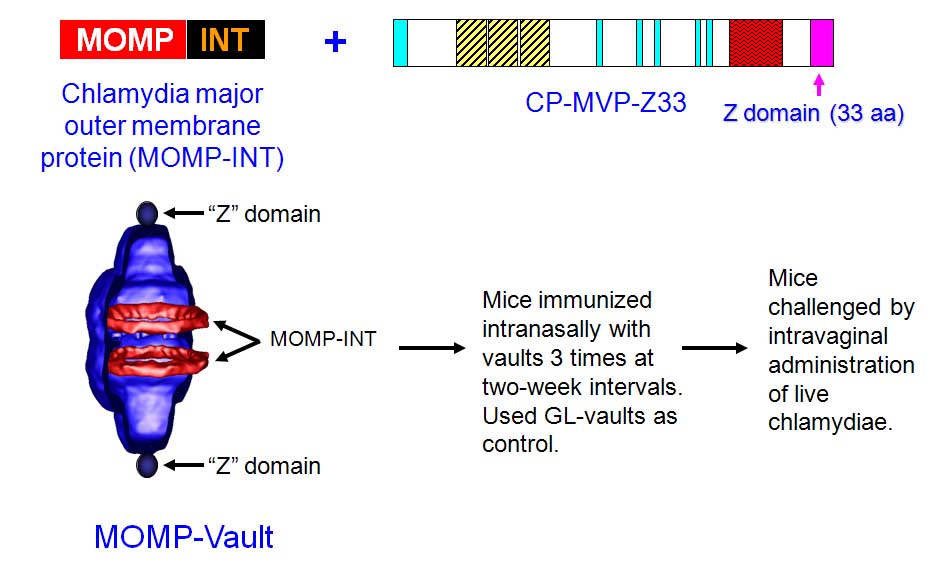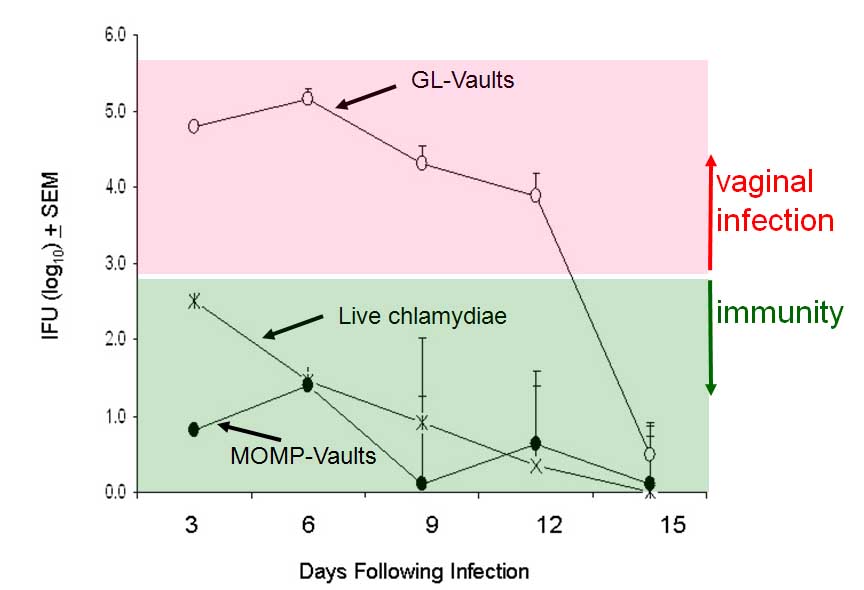Big Kids: Vaults as "Smart Adjuvants"
Vault immunogenicity. As a naturally-occurring nano-scale capsule, the vault particle appears to be an ideal structure to engineer for targeting to tissues. As vaults are highly stable structures when isolated and examined in the laboratory, it is reasonable to propose that the particles will be stable in the bloodstream. Several studies indicate that vaults do not induce antibody formation. First, when the Rome Laboratory tried to make anti-vault antibodies in rabbits, they found no antibodies were made to purified vaults (Kedersha, and Rome, J. Cell Biol. 103: 699-709 (1986)). Furthermore, a large panel of human autoimmune antibodies have been screened and the screen failed to find any evidence for antibodies against any of the vault proteins (Rome, unpublished). Immunogenicity studies in mice were recently carried out (Champion., et al., PLoS One. 4: e5409 (2009)). In a nasal spray delivery model, recombinant vaults failed to elicit an antibody response.
A Vault Vaccine Induces Protective Mucosal Immunity. Immune responses that occur at mucosal surfaces provide superior protection against disease but there are currently no FDA-approved reagents (called adjuvants) which are capable of stimulating immune responses within mucosal tissues. Perhaps one reason is because mucosal immune responses are generated by stimulating mucosal surfaces. However, mucosal surfaces are hostile environments and immunogenic proteins require added protection for delivery to dendritic cells and induction of immunity. In a recent paper (Champion., et al., PLoS One. 4: e5409 (2009)), Recombinant vaults were tested to see if they could provide such protection by encapsulating an antigen and preserving its functional characteristics even within cells. The internal cavity of the recombinant vault is large enough to accommodate multiple immunogenic proteins. Because vaults are the size of small microbes, a vault particle containing an immunogenic protein should be readily taken up into dendritic cells. Further, recombinant vaults containing proteins are straightforward to produce making vaults a viable vaccine delivery scaffold (i.e. adjuvant) if they prove useful and easy to produce for generating immunity at mucosal surfaces. Mucosal immune responses are optimally produced by stimulating mucosal associated lymphoid tissue. Mucosal immune surfaces are interconnected and stimulation of the inductive site in one mucosal surface, produces an immune response at distant mucosal surfaces. In particular, stimulation of the nasal mucosa induces the appearance of immune cells and antibodies in vaginal surfaces. To test the utility of vaults as mucosal vaccine delivery platforms, an infection that relies on cell-mediated mucosal immune responses for elimination and is a significant burden on health care was chosen; Chlamydia trachomatis infection. Vaginal delivery of the mouse adapted strain of C. trachomatis, C. muridarum, induces a local sexually transmitted infection (STI) similar to human chlamydial STI. C. trachomatis is a prominent cause of STI, with approximately 92 million cases occurring annually and is an instigator of female reproductive dysfunction. T helper immune cells (these are called Th1 cells) must be present within vaginal tissues in order to eradicate infection. However, a vaccine has not yet been produced which induces sizeable Th1 immune responses in mucosal tissues. Therefore, an ideal vaccine would elicit a local antichlamydial Th1 cell response in the reproductive mucosa.
Vaults were modified by the addition of a 33 aa peptide (z) derived from staphylococcal protein A to the C-terminus (hereafter referred to as cp-MVP-z). The "z" peptide binds to antibodies at a site distinct from where the antibodies bind to their targets (Kickhoefer et al. ACS Nano 3, 27-36 (2009)). This vault was packaged with a fusion protein produced from the 366 amino acid coding region of the major outer membrane protein (MOMP) of Chlamydia muridarum, fused to the minimal interaction domain (mINT) derived from VPARP (amino acids 1563-1724). A schematic is shown below:

To determine if vaults containing the MOMP protein could induce mucosal immunity, the C. muridarum genital infection model was used. Mice were immunized by delivering the constructed vaults to the nasal mucosa at 2-week intervals for total of three immunizations. This immunization regimen was previously shown to reduce infection following intravaginal challenge when soluble Chlamydia plus various adjuvants were delivered together. Mice immunized with 200 mg of MOMP-vaults were estimated to contain approximately 0.2 mg MOMP. As a negative control, mice were immunized intra nasally with 200 mg GL-vaults and as a positive immunization control (Live-CM), mice were immunized intra nasally with 16 x 10^3 infectious units (IFU) of chlamydiae. Two weeks following the last vault immunization or 4 weeks after the live lung infection, all mice were hormonally synchronized to normalize infectivity. All mice were challenged 1-week later by intravaginal administration with 1.56 x 10^5 IFU chlamydiae (the results are illustrated in the Figure below).

The effect of immunization was first evaluated by monitoring the bacterial burden in vaginal swabs collected every 3 days as reported. Naive, non-immune C57BL/6 mice develop an immune response against C. muridarum and typically clear a genital infection 2-3-weeks later as was observed in mice given GL-vaults. In contrast, delivery of 200 mg MOMP-vaults significantly reduced IFU levels isolated from vaginal swabs compared to the group immunized with GL-vaults (see figure above). More importantly, delivery of MOMP within vaults initially reduced bacterial burden approximately 1 log lower than levels seen in mice naturally immune from a lung infection with live chlamydiae (Live CM). This was remarkable protection since in previous studies only MOMP in the native conformation and not recombinant MOMP could achieve this level of protection.
These data demonstrate that vaults containing MOMP induced a powerful mucosal immunity in the absence of co-delivery with a cytokine or using a live microbial vector. Hence, intra nasal delivery of MOMP-vaults was effective at inducing protective immunity as demonstrated by reducing the magnitude of infection upon intravaginal challenge with C. muridarum.
These data indicate that protein-containing vaults function as "smart adjuvants" by activating selective properties of immune cells that stimulate adaptive mucosal immunity. Investigation of the mechanism by which protein containing vaults stimulate mucosal immunity would further development of vaccines using these particles.